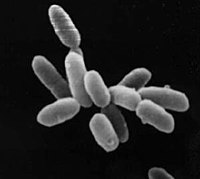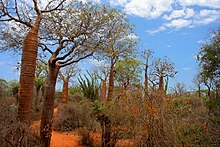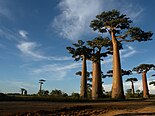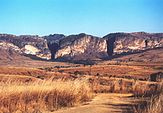A
botanical garden (or
botanic garden)
is a well-tended area displaying a wide range of plants labelled with their botanical names. It may contain specialist plant collections such as cacti and succulent plants, herb gardens, plants from particular parts of the world, and so on; there may be greenhouses, shadehouses, again with special collections such as tropical plants, alpine plants, or other exotic plants. Visitor services at a botanical garden might include tours, educational displays, art exhibitions,
book rooms, open-air theatrical and musical performances, and other entertainment.
Botanical gardens are often run by universities or other scientific research organizations, and often have associated herbaria and research programmes in plant taxonomy
or some other aspect of botanical science. In principle, their role is
to maintain documented collections of living plants for the purposes of
scientific research, conservation, display, and education, although this
will depend on the resources available and the special interests
pursued at each particular garden.

A botanical garden is a controlled and staffed institution for the
maintenance of a living collection of plants under scientific management
for purposes of education and research, together with such libraries,
herbaria, laboratories, and museums as are essential to its particular
undertakings. Each botanical garden naturally develops its own special
fields of interests depending on its personnel, location, extent,
available funds, and the terms of its charter. It may include
greenhouses, test grounds, an herbarium, an arboretum, and other
departments. It maintains a scientific as well as a plant-growing staff,
and publication is one of its major modes of expression.
Historical Development
The history of botanical gardens is closely linked to the history of
botany itself. The botanical gardens of the 16th and 17th centuries were
medicinal gardens, but the idea of a botanical garden changed to
encompass displays of the beautiful, strange, new and sometimes
economically important plant trophies being returned from the European
colonies and other distant lands.
Later, in the 18th century, they became more educational in function,
demonstrating the latest plant classification systems devised by
botanists working in the associated herbaria as they tried to order
these new treasures. Then, in the 19th and 20th centuries, the trend was
towards a combination of specialist and eclectic collections
demonstrating many aspects of both horticulture and botany.

Grand Garden of Ancient History
Early medieval gardens in Islamic Spain resembled botanic gardens of the future, an example being the 11th-century Huerta del Ray garden of physician and author Ibn Wafid (999–1075 CE) in Toledo. This was later taken over by garden chronicler Ibn Bassal
(fl. 1085 CE) until the Christian conquest in 1085 CE. Ibn Bassal then
founded a garden in Seville, most of its plants being collected on a
botanical expedition that included Morocco, Persia, Sicily, and Egypt.
The medical school of Montpelier was also founded by Spanish Arab
physicians, and by 1250 CE, it included a physic garden, but the site
was not given botanic garden status until 1593.

A 16th-century print of the Botanical Garden of Padua—the oldest academic botanic garden still at its original location


 Pavilion Victoria.
Pavilion Victoria. Giant bamboo in Great Pavilion.
Giant bamboo in Great Pavilion.
 A botanical garden is a controlled and staffed institution for the
maintenance of a living collection of plants under scientific management
for purposes of education and research, together with such libraries,
herbaria, laboratories, and museums as are essential to its particular
undertakings. Each botanical garden naturally develops its own special
fields of interests depending on its personnel, location, extent,
available funds, and the terms of its charter. It may include
greenhouses, test grounds, an herbarium, an arboretum, and other
departments. It maintains a scientific as well as a plant-growing staff,
and publication is one of its major modes of expression.
A botanical garden is a controlled and staffed institution for the
maintenance of a living collection of plants under scientific management
for purposes of education and research, together with such libraries,
herbaria, laboratories, and museums as are essential to its particular
undertakings. Each botanical garden naturally develops its own special
fields of interests depending on its personnel, location, extent,
available funds, and the terms of its charter. It may include
greenhouses, test grounds, an herbarium, an arboretum, and other
departments. It maintains a scientific as well as a plant-growing staff,
and publication is one of its major modes of expression. Grand Garden of Ancient History
Grand Garden of Ancient History A 16th-century print of the Botanical Garden of Padua—the oldest academic botanic garden still at its original location
A 16th-century print of the Botanical Garden of Padua—the oldest academic botanic garden still at its original location Halobacteria sp. strain NRC-1,
Halobacteria sp. strain NRC-1, Archaea were first found in extreme environments, such as volcanic hot springs. Pictured here is Grand Prismatic Spring of Yellowstone National Park.
Archaea were first found in extreme environments, such as volcanic hot springs. Pictured here is Grand Prismatic Spring of Yellowstone National Park.
 Green algae from Ernst Haeckel's Kunstformen der Natur, 1904.
Green algae from Ernst Haeckel's Kunstformen der Natur, 1904.  Even, dense
Even, dense 
 Small chapel in the Sonian Forest near the site of the monastery of
Small chapel in the Sonian Forest near the site of the monastery of  Spiny forest at Ifaty,
Spiny forest at Ifaty, 



